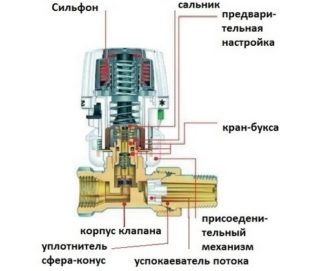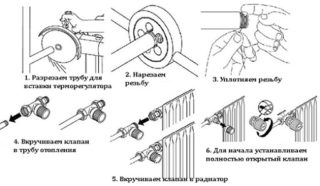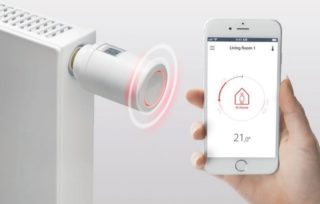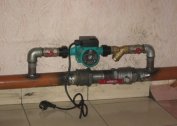Ensuring a comfortable temperature in the home is an important task. For its implementation, various devices are used, which include thermal heads on a heating radiator. They allow you to control the heating temperature in the room and use the heat carrier more rationally. In order for the work to be effective, it is important to choose the right device. To do this, you need to know the maximum information about the properties and characteristics of the device.
Structural features
The thermal head consists of the following parts:
- housing;
- bellows;
- locking mechanism;
- pusher;
- stock;
- spring;
- gaskets;
- fasteners.
The valve is responsible for the amount of coolant passed through.
Typically, the body material is transparent or colored plastic. The bellows are made of brass or steel. Stainless steel springs are responsible for opening and closing the stem. One puts the rod in its original position after closing the valve, and the other after opening.
On the upper part of the housing is a locking part. It allows you to fix the settings. To prevent the element from sticking, it is recommended to dismantle the thermal heads after the end of the heating season.
Varieties of thermal heads
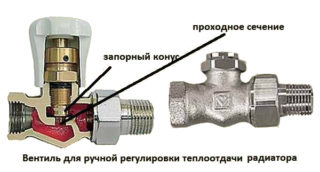 There are 3 groups of thermal heads:
There are 3 groups of thermal heads:
- hand held;
- electronic;
- mechanical.
All of them perform the same function, only the principle of work differs.
Hand held external heads are similar in appearance to a faucet. By turning the regulator, the desired indicator on the coolant is achieved. They are installed instead of the classic ball valves. They are distinguished by their reliability and low cost. Minus - inaccurate settings and inconvenience of use. Also, the regulator may weaken due to frequent use.
Mechanical thermal heads have a more complex design. In this case, the set temperature is maintained automatically. It is based on a bellows in the form of a cylinder, inside of which the agent is in a liquid or gas state. When the temperature rises above the declared norm, the stock starts to move. The channel cross section narrows, the throughput decreases and the temperature drops to the declared value. The advantages of mechanical controllers include ease of use, the accuracy of the setting, automatic adjustment of the mode. The disadvantage is a higher cost.
Electronic models run on batteries. The rod moves under the action of a microprocessor. They have advanced functionality - setting the temperature by time and day of the week, determining the mode in the room, lack of heating in the absence of residents in the house. The main disadvantages of such products are high cost, the need to replace batteries. Advantages - ease of use, full automation of the process, wide temperature range.
Installation Rules
 The thermal head must be installed correctly. Manufacturers give the following connection recommendations:
The thermal head must be installed correctly. Manufacturers give the following connection recommendations:
- The housing must be protected from direct exposure to ultraviolet rays. Otherwise, the accuracy is violated.
- The thermal head must be open. Do not place it behind furniture, protective boxes, or other obstacles.
- Do not place the unit above the heating system. Then the temperature mismatch will be noted.
- The pipe must not exert pressure on the valve.
- During installation, the remote controller is set to maximum. Before the installation itself, the movement of water in the circuit is blocked, and then the liquid is drained.
- Installation is only allowed parallel to the floor in a horizontal position. You can’t vertically set the thermal head.
Then you can proceed with the installation.
Installation sequence
Installing the thermal head begins with pipe trimming. It must be performed at a small distance from the radiator. Next, the old stop valves are demonstrated, the valve shanks are separated and screwed into the battery plugs.
Then the harness is assembled and mounted and pipes connected from the sides of the batteries are connected. By turning the lever, the required temperature is set. The thermostatic head for radiators can be mounted at the input or output of the system.
When choosing the installation location, the manufacturer's recommendations must be followed. Basically, the installation height is 0.4-0.6 meters from the floor. It is for this value that the temperature regime is calibrated. Such criteria are met at top feed. If it is lower, you need to adjust the thermal head to a colder temperature.
Customization Features
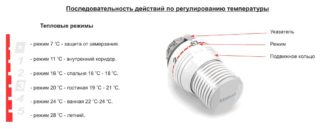 In order for the faucet with the thermal head for the radiator to function correctly, you must perform a preliminary adjustment. It is required to turn on the heating in the room and close the doors and windows. A thermometer is placed at a certain point, and then settings are made. The device configuration scheme is as follows:
In order for the faucet with the thermal head for the radiator to function correctly, you must perform a preliminary adjustment. It is required to turn on the heating in the room and close the doors and windows. A thermometer is placed at a certain point, and then settings are made. The device configuration scheme is as follows:
- Turn the thermal head to the left until it stops. This will open the flow of coolant.
- The expectation of a temperature increase of 5-6 ° C compared to that which was in the room.
- Turn right to the stop.
- Waiting for the temperature to fall to the original. Gradual unscrewing of the valve. Stop rotation in case of positive noise or heating of the radiator.
The last position set is optimal and corresponds to a comfortable temperature.
Common mistakes
Correct installation requires attentiveness from the master at each stage of work to avoid errors. The most common problem is the vertical position of the head. This leads to the fact that the room ceases to be heated, since the temperature regulator itself is heated from the incoming air.
Often choose the wrong installation location. Do not set the controller at a point where the air temperature is very different from the average room. Due to the wrong choice of installation location, the use of a thermal head loses its meaning.
Criterias of choice
Temperature control products are manufactured by many well-known companies. These include Buderus, Danfoss, Aventrop. They have representative offices in all major cities.
To choose the best device, you should rely on the following criteria:
- Thermal valve on which the head is fixed. There are clip and threaded connections.
- Type of thread on the thermal head itself. It happens in the form of a nut with blinds or round.
- The presence of a skirt. It hides the working part and makes the appearance more attractive.
- Material. The cheapest devices are made of plastic, the expensive ones are made of metal. The first unreliable and short-lived.
- The quality of the material. The use of cheap plastic reduces the cost of construction, but it also suffers from durability and working time.
- Type of work item. It happens liquid, gas, electronic, paraffin.
- Smooth rotation of the handle. Affects the accuracy of setting characteristics.
- Availability of additional features. There are wireless models with WiFi, various sensors and other control and adjustment devices.
- Graduation, scale length.
- Is there anti-vandal protection.
- Appearance.
The stores offer ready-made kits consisting of a valve and a thermal head. If desired, these items can be purchased separately. In particular, Rifar and Kermi radiators have to be purchased separately. Danfoss appliances are very popular.
It is also worth choosing in advance which thermal head will be used by the control method. The thermostatic head for a heating radiator with sensors and an automation system is more convenient, but not suitable for all types of batteries.
For cast iron heaters, only manually adjustable models are suitable. This is due to the heat capacity of the material and its large inertia.
